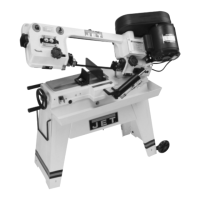14
cover and remove the three wires which
connect it to the power cable.
6. Remove the four nuts, bolts and washers
which hold the motor to its mounting plate.
7. Remove the motor from the saw.
8. Reinstall the replacement motor and pulley by
reversing steps 7 through 4, above.
9. Loosen the motor mounting plate adjustment
screw so the screw puts no tension on the
plate.
10. Adjust the position of the motor so that:
A. the pulleys are parallel with each other, and
B. the drive belt can just be installed over the
pulleys (It may be necessary to adjust the
drive pulley along the motor shaft to make
the pulleys parallel.)
11. Tighten the motor mounting bolts securely.
12. Tighten the pulley set screw securely.
13. Install the drive belt.
14. Tension the drive belt and complete the
replacement task by performing instructions 6
through 9 in Changing blade speeds.
10.2 Adjusting guide bearings
The outside guide bearing on each of the bearing
seats is mounted on an eccentric shaft to allow
adjustment of the bearing clearance between
bearings and blade, as follows:
1. Loosen the guide bearing shaft lock nut.
2. Use an open end wrench on the hex flats
underneath the guide seat to adjust the
eccentric shaft so the bearing holds the blade
vertically against its opposing bearing. Over-
tightening the blade between the bearings will
only shorten bearing life. Adjust the bearings
so blade is just held firmly in vertical position.
3. While holding the shaft from turning, tighten
the lock nut on the upper side of the bearing
seat.
10.3 Blade tracking
1. If the blade is fully tensioned, release tension
slightly while performing the tracking
operation.
2. If the blade is not on slow speed, change to
the slowest speed according to instructions in
Changing blade speeds.
3. Lift the saw arm to its full up position and lock
it using the hydraulic feed control knob.
NOTE: Use the handle on the arm to lift the
arm. Never use any other part of the arm as a
lifting method.
4. Remove the thumb screw and open the blade
guard cover. Prop it open so you can have
access to the idler wheel.
5. Refer to Figure 17. Use a wrench to loosen
bolt A, a small amount.
Figure 17: Blade tracking mechanism
6. Turn the saw motor ON.
7. Insert a hex wrench into the set screw, B, and
turn it slightly while observing the tracking
action of the blade on the idler wheel. Turning
the hex wrench clockwise will make the blade
track toward the wheel flange. Turning the
wrench counterclockwise will make the blade
track away from the flange.
8. Adjust the set screw in very small amounts
until the blade just starts to track toward the
flange.
9. As you adjust the blade toward the flange,
insert a strip of paper between the blade and
wheel as shown in Figure 18.
Use a strip of paper six
inches long or longer so your hands stay
clear of the moving parts of the saw.
Figure 18: Checking blade tracking
10. Keep using small amounts of adjustment to
move the blade toward the flange, testing with
the paper strips, until the paper is cut between
the blade and flange.
11. When the paper is cut, turn the hex wrench
slightly in the opposite direction so the blade
does not track while touching the flange.
12. Tighten bolt A.

